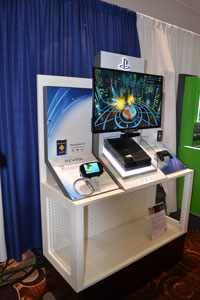8/27/2014
Exploring the Senses: The Power of Touch
Jennifer Polanz
Online retail is a growing beast, but it has its limitations, and one of them is appealing to the sense of touch. No matter how great an image is on screen, it isn’t the same as a customer reaching out and touching it. There’s scientific evidence to show that consumers, particularly ones classified as “need for touch,” or NFT, are more persuaded by a product if they’re allowed to touch it. One study, published in October 2006 in the Journal of Marketing, tested this theory multiple times. It showed when NFTs were able to touch an item, they felt more persuaded by it—in this study’s case it was a brochure. It’s also important to note in those studies the sense of touch provided no additional information, yet the power of touch alone still led to a more positive feeling.
To continue on with that line of study, researchers looked at the importance of touch when it comes to perceived ownership. In a study published in 2009 by the Journal of Consumer Research, researchers came up with four different scenarios using a variety of objects like playfoam, Slinky toys, mugs and pencils to test the theory. In all four studies, they found “touch leads to increased perceived ownership and this increase in perceived ownership then leads to an increase in valuation of an object if the object provides neutral or positive sensory feedback.”
What does all this mean? It means get rid of signs that say “Do Not Touch!” You could be reducing your sales by not letting customers handle the merchandise. Those fairy garden displays you worked so hard on? Let your customers move them around—show them how fun it is to place the fairies in different spots. You may suffer some breakage, but your customers’ purchases could offset the costs and then some. Display gardens are another great way to get customers to touch the products, particularly something like a sensory garden full of bracteantha, stachys, celosia and other highly touchable plants (stay tuned, we’ll run a sensory garden story in our Theme Gardens series in the next month or two in the magazine).

These are not new concepts, either. The world of electronics has embraced the power of touch by letting customers fiddle with phones, cameras, laptops, TVs and video games. In fact, the PlayStation 4 display shown here won a display award at the recent Global Shop trade show in Las Vegas for its setup allowing customers to grab the controller and go to town on a game. This is the norm now for most big box retailers.
Pictured: This PlayStation 4 display won an award at the Global Shop trade show for its setup, which allows customers to pick up the controller and experience the game firsthand.
It’s also something most packaging companies are becoming aware of and now you see more openings in packaging allowing consumers to poke their finger through and touch the product inside. This is widely used in toy packaging, too.
It’s worth a run-through at the garden center to look at displays to see how touchable they are. If you have lots of products in packaging, put out samples or unpackage one or two. One of the studies talked of a supermarket where sales of toilet paper increased when they pulled a few of each out of the packaging and displayed it so customers could touch and compare. Your plants are out and ready for touching, but what about other items? Media is a good one to set out samples for, along with any food items you may sell and even products like irrigation systems. Remember, if a person gathers information through touch, then they are more likely to respond to products they can handle than ones in packaging.
GP